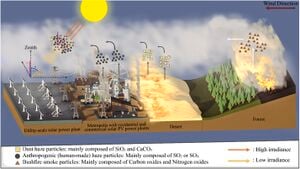A Review of the Effects of Haze on Solar Photovoltaic Performance

Solar photovoltaic (PV) deployments are growing rapidly to provide a sustainable source of electricity, but their output is strongly impacted by environmental phenomena such as soiling and low irradiance conditions induced by haze from urban sources, dust, and bushfire smoke. This review examines the effects of haze on PV performance, highlights significant results, and identifies apparent research gaps in the current literature. In addition to the severe health issues caused by industrial exhausted aerosol, dust storms particles, and bushfire smoke, reduction in irradiance (in some cases up to 80%) is the most dominant impact of these sources of haze. Haze also causes changes in the received solar spectrum, and higher bandgap PV materials are more affected by the presence of haze and aerosols in the atmosphere by 20-40% than low bandgap semiconductors. In many cities throughout the world, pollution-related haze causes substantial annual revenue loss to PV operators. In addition, haze imposes severe effects on direct irradiance; therefore, tracking systems and concentrated PV systems are most affected. These technical impacts of haze all indicate the need for careful customization of PV systems for specific locations. In addition, to increase global PV output, it is clear that air pollution control regulations such as China's national policies against air pollution and eco-friendly international actions such as COP26 should be employed and executed. Further studies are needed including indoor experiments, forecasting future implications of aerosols on PV energy conversion, and performing energy policy analysis to identify associated challenges and propose practical strategies.
Highlights[edit | edit source]
- Solar photovoltaic (PV) strongly impacted by environmental phenomena induced by haze.
- Industrial exhausted aerosol, dust storms particles, bushfire smoke cut irradiance.
- Haze changes in received solar spectrum, and higher bandgap PV 20-40% cut.
- Pollution-related haze causes substantial annual revenue loss to PV operators.
- Haze imposes most severe effects on direct irradiance; tracking + concentrated PV systems.
See also[edit | edit source]
- The Impact of Snow Losses on Solar Photovoltaic Systems in North America in the Future
- Snow Losses for Photovoltaic Systems: Validating the Marion and Townsend Models
- Monofacial vs bifacial solar photovoltaic systems in snowy environments
- A new method to determine the effects of hydrodynamic surface coatings on the snow shedding effectiveness of solar photovoltaic modules
- Impact of Snow and Ground Interference on Photovoltaic Electric System Performance
- Prediction of energy effects on photovoltaic systems due to snowfall events
- Solar resource measurement for PV applications
- Performance of Bifacial Photovoltaic Modules on a Dual-Axis Tracker in a High-Latitude, High-Albedo Environment
- Differences in Snow Shedding in Photovoltaic Systems with Framed and Frameless Modules
- Image Analysis Method for Quantifying Snow Losses on PV Systems




